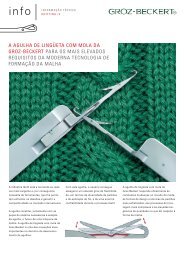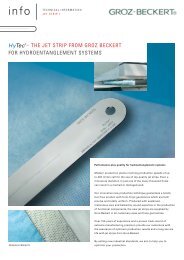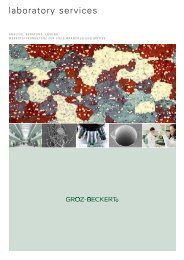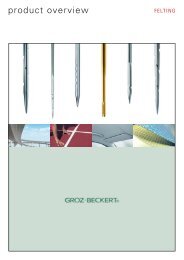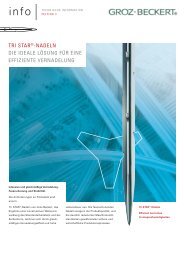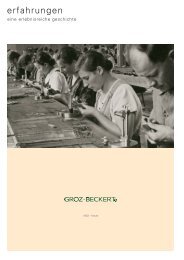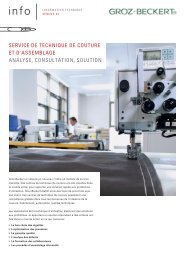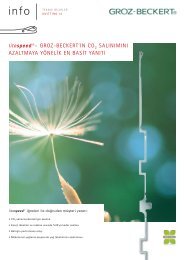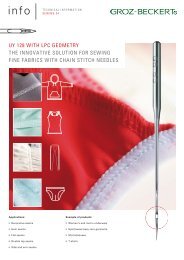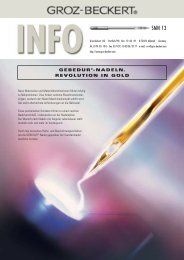Create successful ePaper yourself
Turn your PDF publications into a flip-book with our unique Google optimized e-Paper software.
info<br />
TECHNICAL INFORMATION<br />
SEWING <strong>17</strong><br />
THE RIGHT NEEDLE –<br />
FOR PROBLEM FREE PROCESSING<br />
OF FINE KNITWEAR – SAN ® 10<br />
The demand for fine and very fine fabrics with delicate stitching is<br />
steadily increasing. For this reason, the standards for seams have<br />
also increased. As soon as seams are worn directly next to the skin,<br />
not only elegance and attractiveness are important – softness and<br />
comfort also come into play.<br />
Flawless sewing results with such fine materials call for very high<br />
quality standards for the needles. Often, needles designed for<br />
special applications must be used in order to guarantee process<br />
reliability during sewing.<br />
Choosing the "right" sewing machine needle is one of the most<br />
important requirements.
PAGE 2<br />
| info | SEWING <strong>17</strong><br />
CHOOSING A NEEDLE SYSTEM<br />
Which needle system is used is generally<br />
dictated by the type of machine used and<br />
the sewing job in question. Within this<br />
needle system, there are variants that a<br />
user can choose from to meet specific<br />
requirements.<br />
This choice involves the following<br />
questions:<br />
• Which needle thickness?<br />
• Which point shape?<br />
• Use of a standard needle or a special<br />
application needle?<br />
As your partner, <strong>Groz</strong>-<strong>Beckert</strong><br />
guarantees:<br />
• Innovative needle development that is<br />
close to the market<br />
• Optimised needle geometry and<br />
excellent mechanical properties<br />
• Needles with top uniformity and close<br />
tolerances<br />
• Technical service and application<br />
advice<br />
• World-wide availability<br />
Standard needle<br />
Main characte r istics<br />
for selection<br />
of the right needle<br />
Needle thickness<br />
Point shape<br />
The advantages of <strong>Groz</strong>-<strong>Beckert</strong> needles<br />
The user benefits from:<br />
• High needle quality<br />
• High process reliability<br />
• Cost reduction<br />
• Improvement in quality<br />
• Less machine downtime<br />
• Solutions for new fabrics and trends<br />
• Support with solving sewing<br />
problems<br />
• Support with quality planning
SELECTING THE IDEAL NEEDLE THICKNESS<br />
Guideline: as thick as possible and as thin<br />
as necessary.<br />
Using very thin standard needles can<br />
solve quality problems at the expense<br />
of output.<br />
CHECKING SEAMS: SLIGHT PULLING AND SHEARING<br />
MOVEMENTS MAKE MATERIAL DAMAGE VISIBLE (FIG. 2)<br />
STITCHES IN THE KNITTING ARE DAMAGED – TEST IS<br />
CONTINUED WITH THE NEXT SIZE DOWN OF NEEDLE<br />
THICKNESS.<br />
NO MORE MATERIAL DAMAGE VISIBLE – CORRECT<br />
NEEDLE THICKNESS HAS BEEN FOUND.<br />
The test sequence described here can<br />
also be used with the causes of faults<br />
described on page 5.<br />
TEST IS REPEATED<br />
TEST IS REPEATED<br />
Test sequence using material damage as an example<br />
YES<br />
NO<br />
<strong>Sewing</strong> test with needle thickness<br />
Nm 75, RG or FFG point<br />
Seam tested for material damage – manually or<br />
with machine (e.g. at <strong>Groz</strong>-<strong>Beckert</strong> <strong>Sewing</strong><br />
Technology Centre in accordance with DIN 53882)<br />
Material damage visible<br />
YES<br />
Reduction of needle<br />
thickness step by step<br />
appleNm 70, 65, 60, (55, 50)<br />
Test of whether needle thickness<br />
can be increased further<br />
NO<br />
Needle thickness ideally matched for gentle<br />
action on fabric.<br />
Missed stitches, broken thread,<br />
low output<br />
YES<br />
Test with SAN ® 10 needle (see page 6)<br />
End of test<br />
| info | SEWING <strong>17</strong><br />
NO<br />
TEST IS REPEATED<br />
PAGE 3
SELECTING THE MOST SUITABLE NEEDLE POINT<br />
The following are<br />
available:<br />
Ball points RG, FFG,<br />
FG and SKL<br />
Round points R, RS<br />
(not for knitted<br />
fabrics)<br />
Requirement for<br />
optimum process<br />
stability:<br />
• Regular testing of<br />
the point is<br />
essential<br />
• Replacement of a<br />
needle in good<br />
time increases<br />
the process<br />
stability<br />
| info | SEWING <strong>17</strong><br />
RG FFG FG SKL R RS<br />
Fine knitted fabrics Fine woven fabrics<br />
Application<br />
Selection<br />
of point shape:<br />
Application<br />
…for fine interlock fabrics<br />
…for multi-head embroidery<br />
…for sewing on buttons<br />
…for single and ribbed knits<br />
…for fine and very fine knitted fabrics<br />
with elastane content<br />
…for knitted fabrics with increased<br />
elastane content<br />
…for fabrics with an open structure<br />
(tulle)<br />
…for warp knit and underwear<br />
fabrics with bare elastane yarns<br />
NEEDLE POINT TEST: DRAW NEEDLE POINT LIGHTLY<br />
OVER FINGERNAIL AND SEE IF IT LEAVES SCRATCH<br />
MARKS.<br />
RG<br />
FFG<br />
FG<br />
SKL<br />
R<br />
RS<br />
…for multi-head embroidery<br />
…for standard chainstitch<br />
…in the event of fabric damage<br />
…for fine to very fine woven fabrics<br />
…in the event of fabric damage<br />
…for straight seams<br />
…for lockstitch<br />
…for extremely straight seams<br />
... in the event of tendency to pull<br />
threads in lockstitched seams<br />
PAGE 4
PROBLEMS IN USE<br />
| info | SEWING <strong>17</strong><br />
There is currently a wide variety of materials available that are fine and difficult to sew,<br />
and consequently problems often occur in use.<br />
The causes of sewing problems are very diverse. They can be due to the machine, the<br />
fabric, the machine operator, the climate, the sewing thread or the needle. In addition,<br />
users often want different seam structures and seam types combined with varying<br />
numbers of fabric layers and thicker areas. In this document, we shall deal only with<br />
needle-related faults.<br />
Material damage<br />
• Needle too thick<br />
• Wrong point shape<br />
• Damaged needle point<br />
Seam puckering<br />
• Needle too thick<br />
• Wrong needle point<br />
Missed stitches<br />
• Needle too thin<br />
• Thread not suitable for needle thickness<br />
Broken thread<br />
• Needle too thin<br />
• Thread not suitable for needle thickness<br />
Broken needle<br />
• Needle too thin<br />
• Wrong point shape<br />
PAGE 5<br />
Possible needle-related causes Effect Possible solutions<br />
• Use a thinner needle<br />
• Select a suitable needle point<br />
• Check the needle point<br />
• Use a <strong>Groz</strong>-<strong>Beckert</strong> SAN ® 10 needle<br />
• Use a thinner needle<br />
• Select a suitable needle point<br />
• Use a <strong>Groz</strong>-<strong>Beckert</strong> SAN ® 10 needle<br />
• Use a thicker needle<br />
• Match the thread thickness to the<br />
needle thickness<br />
• Use a <strong>Groz</strong>-<strong>Beckert</strong> SAN ® 10 needle<br />
• Use a thicker needle<br />
• Match the thread thickness to the<br />
needle thickness<br />
• Use a <strong>Groz</strong>-<strong>Beckert</strong> SAN ® 10 needle<br />
• Use a thicker needle<br />
• Select a suitable needle point<br />
• Use a <strong>Groz</strong>-<strong>Beckert</strong> SAN ® 10 needle
GROZ-BECKERT KG<br />
PO Box 10 02 49<br />
72423 Albstadt, Germany<br />
Phone +49 7431 10-0<br />
Fax +49 7431 10-3200<br />
contact@groz-beckert.com<br />
www.groz-beckert.com<br />
| info | SEWING <strong>17</strong><br />
SPECIAL APPLICATION NEEDLE SAN ® 10<br />
IDEAL FOR HIGH QUALITY WITH A HIGH OUTPUT<br />
The advantages of the <strong>Groz</strong>-<strong>Beckert</strong> SAN ® 10 at a glance:<br />
• Higher stability while gentle on fabric<br />
• Reduction of missed stitches<br />
• Reduction of needle breakage<br />
• Suitable for sewing fabrics that are difficult to sew<br />
• Possible to use thicker threads with the same needle<br />
thickness<br />
• Increased productivity<br />
STANDARD NEEDLE<br />
BULKED YARN<br />
MULTI-NEEDLE MACHINE<br />
SAN ® 10<br />
Machining fabrics that are difficult to sew<br />
Knitted, warp and weft threads are pushed<br />
out of place and subjected to high friction<br />
when a needle penetrates them. In extreme<br />
cases, this can cause splitting damage.<br />
Fine fabrics with an inadequate finish are<br />
consequently very difficult to sew without<br />
causing damage. The shank geometry of<br />
Bulked yarns are often sewn with very<br />
thin needles. Problems can arise right at<br />
the beginning because it is difficult to<br />
thread the needle. Then there is often a<br />
fault in the thread slipping properties<br />
during sewing, which can cause missed<br />
stitches, broken threads or broken needles.<br />
In multi-needle machines, the needles<br />
are clamped in place at different heights,<br />
because they have different functional<br />
cycles. For this reason, the needles sink<br />
into the fabric by different depths. The<br />
needles that penetrate the furthest are<br />
placed under particularly high demands<br />
the <strong>Groz</strong>-<strong>Beckert</strong> SAN ® 10 needles that is<br />
specially gentle on fabric makes it possible<br />
to sew fabrics like this with practically no<br />
difficulties.<br />
Machining jobs with thin needles in combination with bulked yarns<br />
Use in multi-needle machines<br />
<strong>Groz</strong>-<strong>Beckert</strong> recommends using SAN ® 10 needles for:<br />
• Fabrics with a high tendency to be damaged during sewing<br />
• Extremely sensitive fabrics that can only be sewn at<br />
minimal speeds and with extremely thin needles<br />
• <strong>Sewing</strong> with bulked yarns and elastic yarns<br />
• Use in multi-needle machines<br />
The specially adapted eye geometry of the<br />
<strong>Groz</strong>-<strong>Beckert</strong> SAN ® 10 has clear advantages<br />
in this area.<br />
as far as gentleness on the material and<br />
their own stability are concerned. Due<br />
to the special shaping of the shank,<br />
<strong>Groz</strong>-<strong>Beckert</strong> SAN ® 10 needles meet these<br />
requirements better than other needles.<br />
The depictions provided of our products are not to scale and are<br />
intended for illustrative purposes only. Consequently they make<br />
no claim to be an accurate representation of the original.<br />
® = Registered trademark of the <strong>Groz</strong>-<strong>Beckert</strong> company group.<br />
© = This publication is copyrighted. All rights reserved, in particular<br />
the right of duplication, distribution and translation. This<br />
publication or any parts thereof may not be reproduced or stored,<br />
processed, duplicated or distributed using electronic systems<br />
in any form or by any means whatsoever without the express<br />
written consent of <strong>Groz</strong>-<strong>Beckert</strong>.<br />
EN I 05.2011



